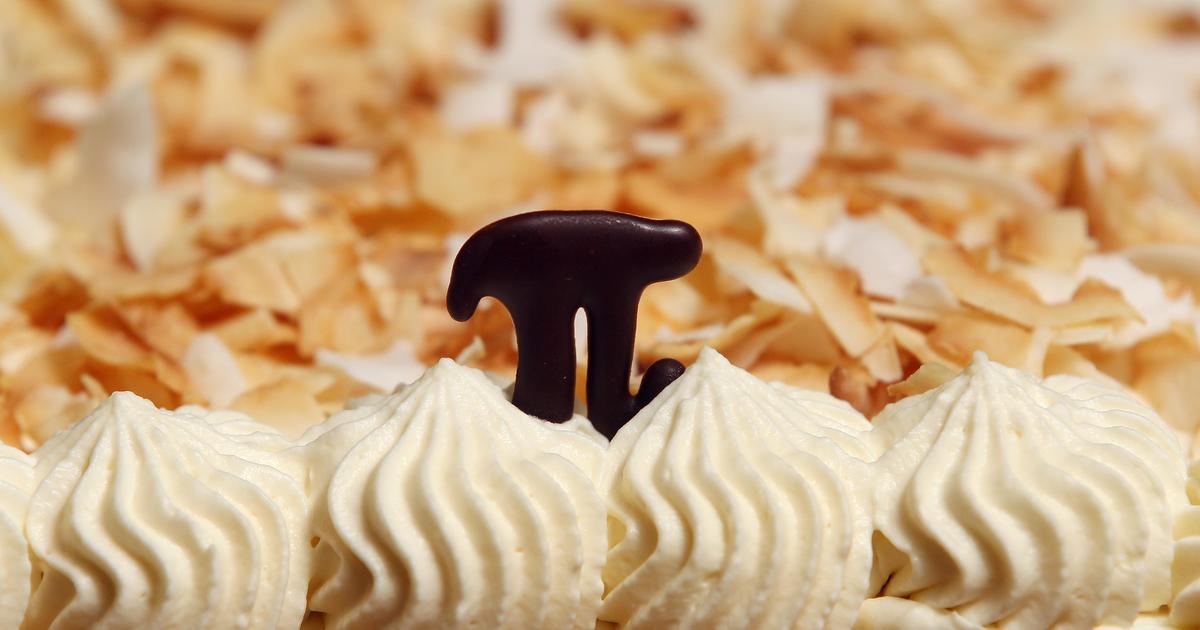CBS News
What is Pi Day? Things to know about the holiday celebrating an iconic mathematical symbol

Thursday marks National Pi Day in the United States and around the world. The holiday commemorates a timeless symbol beloved by many in mathematical and scientific communities, while making the most of the opportunities it allows for humorous wordplay, dessert and “teachable moments,” as some experts have said.
What is pi?
Pi is a special number — so special, in fact, that most laypeople are probably aware of it, even if only as a relic of bygone classroom lectures or geometry textbooks. Represented in abbreviated form by the somewhat familiar sequence 3.14, pi, or the Greek letter π, is an iconic symbol seen in mathematical equations and, in more recent decades, merchandise like T-shirts, sweatshirts and coffee mugs.
It’s actually a ratio, denoting the relationship between the circumference and the diameter of a circle. If the outline of a circle is traced, unwound and then measured, the length is called its circumference. The length of a line drawn straight through the center of a circle and extending out to its edges is called the diameter. Dividing the circumference by the diameter of any and all circles will yield the same result: pi — and that’s true for all circles, regardless of size.
Pi is a constant or “universal” number, which is a value that does not change no matter its circumstances. That means π is always equal to 3.14, more or less. After those three famous digits comes an endless “irrational” sequence without permanent patterns or repeating sections. Even though the sequence continues indefinitely, pi enthusiasts have made hobbies out of memorizing and reciting as many decimal places as possible. The Guinness World Record is 70,000.
Why is pi important?
The ratio is beloved by math and science enthusiasts for a reason: Pi serves critical functions in many of the most basic and the most complex equations. It’s necessary to calculate the area and the volume of everything circular and spherical, and it allows humans to measure the sizes of tiny things, like molecules, in a similar way it allows them to estimate the sizes of massive things, like Earth, the moon, other planets and the sun. Pi helps NASA engineers build spacecraft just as it helps scientists study newly discovered worlds. It’s also fundamentally related to gravity.
Manil Suri, a mathematics and statistics professor at the University of Maryland, Baltimore County, said pi helps people understand more about the world, the universe and how they work.
“It’s quite amazing that there is such a constant that is true for all circles. That’s what really gets me. Draw any circle and the circumference divided by the diameter will always be the same number. It’s a little chilling in a way,” said Suri. “I think, symbolically it just shows that there are certain laws that the universe follows, and these are mathematical, and for me as a mathematician, that’s key. Whether we measure measure it in meters or feet or whatever, whether we exist or not, this number will always be the same. That’s the kind of amazing thing.”
Pi comes up frequently and often unexpectedly in the answers to “thousands and thousands of different math problems,” said Daniel Ullman, a mathematics professor at George Washington University who also called pi “an amazing curiosity.”
“My preferred take is not to ask the question, ‘Why is pi important?’ Because I can try to explain why the number six is important, but it’s just another number. Pi is just the name of a particular spot on the number line,” Ullman said.
“The question really is, ‘Isn’t it amazing that this number arises in millions of different settings that seem to have nothing to do with each other?'” he said. “You ask a reasonable question, and the answer turns out to be something with a pi in it. It’s the surprising appearance of this same number over and over and over again that makes it interesting.”
What is Pi Day?
Pi Day is celebrated annually on March 14, since the date written numerically corresponds with the first three digits of π. (Pi Day was particularly momentous in 2015, when the numerical date corresponded with π up to five digits: 3.1415.) It is also coincidentally the birthday of Albert Einstein.
People and civilizations have known about pi for thousands of years, with evidence indicating an approximated measurement was used by the ancient Babylonians and ancient Egyptians. The first calculation of pi was done by Archimedes, a legendary mathematician of the ancient world, in the centuries leading up to the common era.
But the holiday did not come to be until 1988. It was founded by physicist Larry Shaw, who at the time was on staff at the Exploratorium, a science museum in San Francisco. It began at an Exploratorium staff retreat in Monterey, California, which Shaw and his colleagues took to mark three years since the death of Robert Oppenheimer, who founded the Exploratorium. Shaw drew the connection between 3.14 and March 14 during that retreat, and the first informal Pi Day was celebrated that same year at the museum to honor Oppenheimer’s memory.
Pi Day became a nationally recognized in the U.S. decades later, thanks to a binding resolution passed by the House of Representatives on March 12, 2009, designating March 14 as National Pi Day.
How to celebrate Pi Day
As an official Pi Day website suggests, eating pie, baking pie and perhaps observing the mathematical principles of pi using a pie are some thematic activities to enjoy. Pizza pies and dessert pies are both appropriate variations. A play on traditional “pie contests,” pi contests are common on Pi Day and often involve competitions to recite as many digits of π as possible from memory.
But there are no right or wrong ways to celebrate Pi Day. For people around the world excited by the mathematical significance of pi and the broad potential for honorary puns related to it, there are plenty of ways to pay homage. The same goes for educators and students, although math and science experts do generally recommend using Pi Day festivities as opportunities to make learning more fun. The Children’s Museum of Houston, for example, will ring in the holiday with its 14th annual pie fight, inviting kids to throw pies made of shaving cream at one another in a cordoned-off section of the street outside.
Math fans acknowledge that typical Pi Day celebrations have little to do with the mathematical constant. Suri would still encourage educators to take full advantage of the fun holiday, though, and always bring pie to class when teaching on Pi Day.
“Any time I have a lecture on Pi Day, that’s the way to go,” he said. “And I’d recommend it for all professors. Get a pie. People will love it. They’ll listen to your lectures with much more attention.”
CBS News
Taste-testing “Sandwiches of History” – CBS News

Watch CBS News
Be the first to know
Get browser notifications for breaking news, live events, and exclusive reporting.
CBS News
“Sandwiches of History”: Resurrecting sandwich recipes that time forgot

Barry Enderwick is eating his way through history, one sandwich at a time. Every day from his home in San Jose, California, Enderwick posts a cooking video from a recipe that time forgot. From the 1905 British book “Salads, Sandwiches and Savouries,” Enderwick prepared the New York Sandwich.
The recipe called for 24 oysters, minced and mixed with mayonnaise, seasoned with lemon juice and pepper, and spread over buttered day-old French bread.
Rescuing recipes from the dustbin of history doesn’t always lead to culinary success. Sampling his New York Sandwich, Enderwick decried it as “a textural wasteland. No, thank you.” Into the trash bin it went!
But Enderwick’s efforts have yielded his own cookbook, a collection of some of the strangest – and sometimes unexpectedly delicious – historical recipes you’ve never heard of.
Harvard Common Press
He even has a traveling stage show: “Sandwiches of History Live.”
From the condiments to the sliced bread, this former Netflix executive has become something of a sandwich celebrity. “You can put just about anything in-between two slices of bread,” he said. “And it’s portable! In general, a sandwich is pretty easy fare. And so, they just have universal appeal.”
Though the sandwich gets its name famously from the Fourth Earl of Sandwich, the earliest sandwich Enderwick has eaten dates from 200 B.C.E. China, a seared beef sandwich called Rou Jia Mo.
He declared it delicious. “Between the onions, and all those spices and the soy sauce … oh my God! Oh man, this is so good!”
While Elvis was famous for his peanut butter and banana concoction, Enderwick says there’s another celebrity who should be more famous for his sandwich: Gene Kelly, who he says had “the greatest man sandwich in the world, which was basically mashed potatoes on bread. And it was delicious.”
Whether it’s a peanut and sardine sandwich (from “Blondie’s Cook Book” from 1947), or the parmesian radish sandwich (from 1909’s “The Up-To-Date Sandwich Book”), Enderwick tries to get a taste of who we were – good or gross – one recipe at a time.
RECIPE: A sophisticated club sandwich
Blogger Barry Enderwick, of Sandwiches of History, offers “Sunday Morning” viewers a 1958 recipe for a club sandwich that, he says, shouldn’t work, but actually does, really well!
MORE: “Sunday Morning” 2024 “Food Issue” recipe index
Delicious menu suggestions from top chefs, cookbook authors, food writers, restaurateurs, and the editors of Food & Wine magazine.
For more info:
Story produced by Anthony Laudato. Editor: Chad Cardin.
CBS News
The cream of the crop in butter

Watch CBS News
Be the first to know
Get browser notifications for breaking news, live events, and exclusive reporting.








